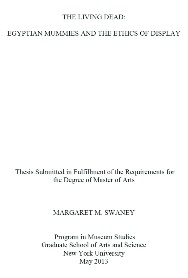| Main » Ad Board » ДРЕВЕН ЕГИПЕТ И АФРИКА » Египтология и история на откритията |
| 05.11.2020, 16:40 | |
Една от актуалните и набиращи сила, макар и спорни тенденции в съвременното, особено американско, музейни дело, е съхраняваните и излагани като част от експозицията човешки останки да бъдат третирани със съответното уважение като такива, и то съгласно вярванията и обичаите на съответната култура, към която е принадлежал приживе мъртвият. На този във висша степен дискусионен аспект на музейната етика по отношение на древноегипетските мумии е посветено настоящото изследване. - на английски език, от Google Drive, формат PDF. Сваляне с ляв бутон (downloading by left button) от страницата на предоставящия сървър, после през бутона стрелка надолу/after by down arrow button. АЛТЕРНАТИВЕН ЛИНК / ALTERNATIVE LINK: - на английски език, от Research Gate, формат PDF.Сваляне с ляв бутон (downloading by left button) и после през бутона Download.
| |
| Views: 829 | Placed till: 11.12.2020 | Rating: 0.0/0 | |

